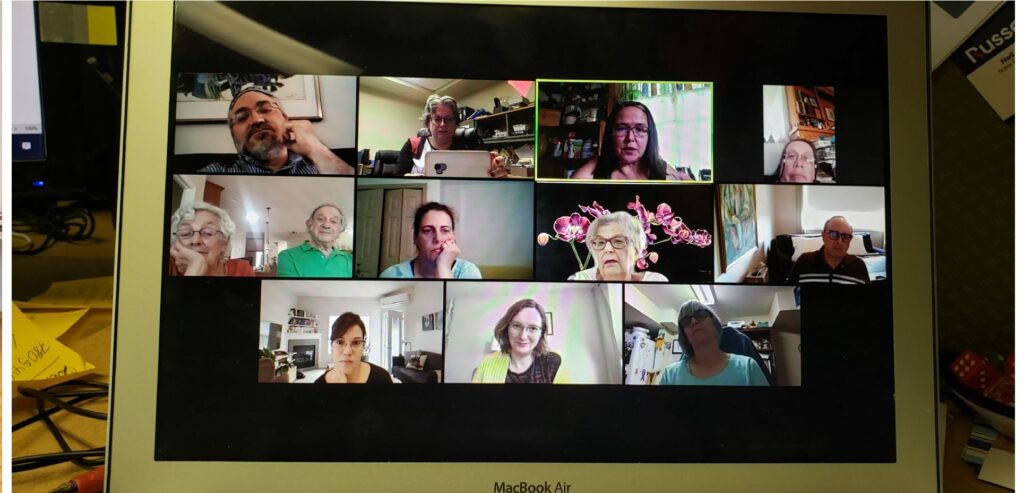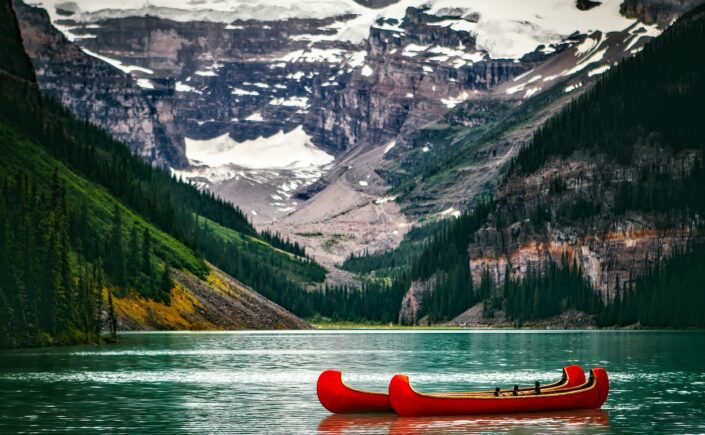Naomi McIlwraith, poet and educator, graciously provided the text of her presentation to include on this site, as an exemplar.
nakiskâtotân kihci-mâmawipayiwinihk tastawâyihk
Let’s Meet at the Great Gathering Place In-Between
Introduction:
Thank you Orly, Svetlana, and Anna Marie for coordinating these important “Survival to Thrival” gatherings. In this spirit of gathering and meeting I call my talk today, “nakiskâtotân kihci-mâmawipayiwinihk tastawâyihk – Let’s Meet at the Great Gathering Place In-Between.” Thank you, Hunter, for moderating our virtual gathering today. And a special thank you to Anna Marie for asking me to share my thoughts here. It is a great honour for me to tell you all a bit about what’s on my mind these days. I come to you all in peace.
When Anna Marie asked me to talk about “Living in Two Worlds,” I thought of the life giving North Saskatchewan River issuing from its source, the Saskatchewan Glacier, traversing Alberta, Saskatchewan, and a good chunk of Manitoba, and eventually spilling into Lake Winnipeg – wînipêk sâkahikan.
Before I jump in, I want to say that I will use the word “Indian” both cautiously and truthfully here, cautiously because it is inaccurate and hurtful, and truthfully because at least one of my maternal ancestors is described in the historical documents as “Nancy Indian.” You will also hear some Cree words and phrases – nêhiyaw itwêwina – in my talk today; the English you hear just before or just after the Cree is the translation.
tânisi nitôtêmitik. Naomi McIlwraith nitisiyîhkâson. amiskwacî-wâskahikanihk ohci niya. nôhtâwipân ê-kî-ohci-môso-tâpiskanihk êkwa ayîkisâkahikanihk. nikâwiy ohci Lestock, Saskatchewan. nôhtâwipân ê-kî-pakaskît ayisk nôcokwêsiwak aniki kâ-kî-ohpikihikot êkwa mîna kî-nêhiyawi-kiskinwahamâkot êkwa kî-kiskinwahamâkot kâ-nihtâ-nêhiyawêt. mâka môya ê-kî-nêhiyawit; ê-kî-môniyawit nôhtâwîpân. tâpwê nikâwiy ê-miyo-âpihtawikosisâniskwêt âta môya ê-nêhiyawêt; ê-pîkiskwêt miyo-pîkiswêwin sâkihitowin êkwa kisêwâtisiwin.
Hello, my friends. My name is Naomi McIlwraith. I am from Beaver Mountain House, more commonly known as Edmonton. My late father was born in Moose Jaw, Saskatchewan but was raised at Frog Lake from the age of 4 until 14 years. My mother is from Lestock, Saskatchewan. My late father spoke such good Cree it was like brilliant colours because the old ladies, those ones who raised him and taught him Cree ways also taught him to speak Cree exceptionally well. But my late father was not nêhiyaw; he was a white man. It is the truth that my beautiful Mom is a Métis woman, but she does not speak Cree. She does, however, speak the good language of love and generosity.
Section 1: Response to Dr. Tallbear’s Talk
After Dr. Kim Tallbear’s “Wannabee” talk on why so many white people claim to be Indian, I thought about what Vine Deloria, the Standing Rock Sioux scholar said about the “imaginary Indian grandmother”:
While a real Indian grandmother is probably the nicest thing that could
happen to a child, why is a remote Indian princess grandmother so necessary
for many whites? Is it because they are afraid of being classed as foreigners?
Do they need some blood tie with the frontier and its dangers in order to
experience what it means to be an American? Or is it an attempt to avoid
facing the guilt they bear for the treatment of the Indians? (https://www.genealogy.com/forum/surnames/topics/adkins/1691/) accessed 2 May 2020.
I thought of Vine Deloria’s derision for white folks like me because Dr. Tallbear explained that one of the reasons white folks claim to be Indian is so they can be less culpable for the history of genocide on our continent. I also thought of Vine Deloria because I was accused of cultural appropriation while I was writing my master’s thesis on the Cree language – nêhiyawêwin – and I have been devastated ever since for having to live inside my white skin, even while being so deeply grateful for the many good and decent white people in my life. And then when Jason asked, “is canoeing an act of cultural appropriation,” I felt hot defensive blood rushing through my veins like a spring flood on the Athabasca River after the ice dam breaks. I respond defensively not to Jason himself but to his question; ironically, though, I am grateful to Jason for asking this question because it gives me the opportunity to navigate the rough waters of cultural conflict.
We all know that water, like fire, is a giver and taker of life. nôhkom, my Grandma Lucabelle, once told me that her uncle drowned in the rough waters of the Winnipeg River – wînipêk sîpiy. My Grandma Lucabelle’s own brother David drowned in what might be called “Bone Lake,” Wascana Lake, but more accurately pronounced in Cree as oskana sâkahikan. As I contemplate water as a life force and a death force, I think too of Dr. Tallbear’s questions:
- Who raised me?
- Who socialized me?
- What community did I grow up in?
Section 2: My Family
I am the fortunate second daughter of Lavona and Mowat McIlwraith. I am also very fortunate to have known all four of my grandparents, Lucabelle and James Meakes and Davida and Charles McIlwraith. And we all lived within walking distance here in amiskwacî-wâskahikan, just north of what in my childhood was Clarke Stadium. My close family ties between my parents and my four grandparents are the blood ties of my socialization. No, I did not grow up on a reserve nor in an established Métis community; but I did grow up with adults who had all been socialized and deeply impacted by their relationships with Indigenous people. As the second very pale daughter of Lavona and Mowat McIlwraith, I was destined to live a life of searching for the centre but never quite finding it.
Today I also want to address the question of “NOT,” especially because I heard someone say that “in-between is not a place of its own, it’s not worth inhabiting.” This statement, I hope, comes from a place not of aggression but of deep, deep sadness. And though I don’t want to assign or inflict sadness on anyone, I do think sadness is a more truthful space than aggression. As a Métis woman struggling with coming to terms with my own “white privilege,” I am personally burdened with the task of living in-between, of living in two worlds, of having to manoeuvre the rough waters of a river in flood. These rough waters include my mother’s numerous experiences with racism during her thirty-seven-year career as a Registered Nurse in the Neonatal Intensive Care Unit. Early in her career, she was denied time off for her wedding and honeymoon; several times throughout her working life, she was treated unfairly and forced to work numerous Christmases in a row or denied holidays during the summer as these privileges were bestowed on younger, white nurses with less seniority than my mother. Again, she was not allowed to switch shifts for her 25th wedding anniversary. I realize that these may seem mild compared to other acts of racism or even genocide experienced by other Indigenous peoples, but some of you will remember in my poem “Critical Race Theory at Canadian Tire” that even a woman from another land felt it was her God-given right to tell my mother, “You’re an Indian. And I don’t help Indians.”
My grandparents raised my Mom and her sister in financially difficult though idyllic environs. My Grandma Lucabelle ‒ Cree, Anishinaabe, Scottish, Norwegian, and French ‒ did not lament to her daughters about racism perhaps because her white husband, my Grandpa Jamie, respected her and treated her as his equal, thus buffering her from the racist world beyond their door. If my Grandma Lucabelle experienced racism, either she didn’t talk about it or she was so tough she didn’t let it bother her. And she was tough! How else could she have survived the loss of four babies. This is why she and my Grandpa adopted my Auntie Ruth, a sister for my Mom. And when my Mom married my Dad, who had been raised amongst the nêhiyawak at the Frog Lake First Nation, the Fishing Lake First Nation, and the Elizabeth Métis Settlement, like his father-in-law, Dad respected Mom and treated her as his equal.
There in the placid waters of respect, equality, and love, my parents raised me and my three natural siblings; Mom and Dad later became foster parents to numerous babies because of my Mom’s expertise as an NICU RN, and they raised my foster sister from infancy to adulthood, despite the calamities and catastrophes of managing the child’s affliction of fetal alcohol spectrum disorder (FASD) and of being accused in court of stealing an Indigenous child from her parents. As a single, childless, white-skinned Métis woman, I am personally burdened with the task of writing about what alcohol has done to our family, even though my parents did not drink and raised us in an alcohol-free home. As the fortunate recipient of an Edmonton Arts Council grant to produce a manuscript of poems about what alcohol has done to our teetotalling Métis family specifically and to Indigenous people generally, I am acutely aware of the dangerous precipice of the Grand Rapids Dam, on the North Saskatchewan River just upstream of where the river spills into the wînipêk sâkahikan, over which I stand as a white-skinned Aboriginal woman writing about the colonial terrors of iskotêwâpoy ‒ fire water. One book well worth your time in reading is Harold Johnson’s Firewater: How Alcohol is Killing My People (and Yours).
Fire ‒ iskotêw ‒ and water ‒ nipiy ‒ takers and givers of life.
It makes a lot of sense that I think of the North Saskatchewan River as a giver of life, as I contemplate living in two worlds because my parents raised me and my sisters and brother here in amiskwacî-wâskahikan so close to this mighty river and because I have spent a lot of time on kisiskâciwani-sîpiy, most notably in 1989 when on a cross-Canada canoe expedition I canoed with five others from Rocky Mountain House, Alberta ‒ asiniy-wâskahikan to Thunder Bay, Ontario ‒ kâ-ministikwê. It makes even more sense that I think of the river as this “in-between place” ‒ tawâyihk ‒ because on the left if you’re paddling downstream is the north shore and on the other side is the south shore. Like the old cliché of the cup being half empty or half full of water depending on how I look at life, I could choose to see the river as a border that separates and divides those on the north shore from those on the south shore, but I choose instead to appreciate the river for providing the north-shore dwellers and the south-shore residents with an inspiring in-between place to meet in harmony and to share the riches of the river.
I say to you now that this “in-between place” is very much worth inhabiting, that living in two worlds can be a happy journey ferrying back and forth between the north shore where live my Cree and Ojibwe relatives ‒ nêhiyawak êkwa Anishinaabe niwâhkomakanak ‒ , and the south shore where live my Scottish, English, Norwegian, and French relatives. On this river where everything is “in-between,” my glass is more than half full of good clean water, and my task is to ferry my big red canoe ‒ nimihkwâcîcîmân ‒ back and forth between the north and south shores. This “in-between” space is sometimes an unhappy site of conflict, for sure, because there are always those who take more than their share; but this “in-between” space can also be a site of generosity, collaboration, and hope ‒ kisêwâtisiwin, mâmawi-wîcihitowin, êkwa pakosêyimowin.
Section 3: The Burden of Living in Two Worlds
But many other questions still challenge me as I contemplate this conundrum of living in two worlds. Who am I if I am a very pale Métis woman, whose canoe was overturned by an accusation of cultural appropriation? Who am I if I am not the coffee-coloured brown of my dear Mom Lavona or the earthier, loamier brown of my dear Grandma Lucabelle? How can I right my big red canoe and be coherent if I am a mixed-blood, if the Métis Nation of Alberta accepts me because I can trace my lineage back to the historically-recognized and politically-powerful Red River Settlement of southern Manitoba? How can I steady my canoe on that fierce eddy line of the mighty North Saskatchewan River as the South Saskatchewan River comes at us from the right where the two rivers meet in central Saskatchewan ‒ kistapinânihk? And what if at this great meeting place some of my relatives are those of the much-contested Eastern Métis?
This is the burden, my friends, of living in two worlds.
Section 4: The Blessing of Living in Two Worlds
Upstream of this great joining of the two rivers, several cities and other communities all contribute to the murky brown waters of the kisiskâciwani-sîpiy. The waters of the South Saskatchewan River ‒ wâwâskêsiw sîpiy (Elk River), in 1989 at least, were bluer and greener ‒ ê-kî-osâwaskwâyiki ‒ almost like an aspen sky on a hot steamy August afternoon. But the rivers join at this great meeting place and flow ever downstream in a richer mix of river colours on their way toward that great inland ocean ‒ wînipêk sâkahikan.
The answer to my many questions about living a good life in-between ‒ ê-miyo-pimâtisiyân kiyâmêwan tastawâyihk ‒ , especially about how to keep my canoe upright and how to be coherent, lies in this image of the confluence of the kisiskâciwani-sîpiy êkwa wâwâskêsiw sîpiy kistapinânihk, where I manoeuvre my canoe, constantly making gentle adjustments with my paddle or leaning my upper body over the gunnels to lean the open top of my canoe counterintuitively downstream to present the closed bottom of my canoe to the forceful waters coming from upstream. Here at the confluence of two mighty rivers I ferry my red canoe back and forth between the north and south shores ‒ ê-âsokâmêpayiyân ‒ , where I honour my late father Mowat Edgar McIlwraith for his enduring kindness and humility and ability not only to speak Cree so beautifully ‒ ê-kî-pakaskît ‒ but also to relate so truthfully and generously to Indigenous peoples, and where I now honour my beautiful Mom Lavona Lillian McIlwraith as I help her stay in her home for as long as possible ‒ my amazing Mom who doesn’t speak nêhiyawêwin âhpo Anishinaabêmowin for all the colonial reasons we can imagine, but who speaks the language of love ‒ sâkihitowin ‒ so humbly, so generously, so truthfully ‒
ê-kitimâkêyimitinân kâkikê êkwa ê-tâpwêskît kâkikê.
Conclusion:
Thank you so much Orly, Svetlana, and Anna Marie and to all of you for this honour to share my thoughts today. I will finish now with a new poem I wrote this past weekend.
My Big Red Canoe ‒ nimihkwâcîcîmân
Let’s go to the Great Gathering Place
itohtêtân kihci-mâmawipayiwinihk.
Come, I’ll take you in my big red canoe.
There, on the other shore, we’ll meet
our friends and relatives, and we’ll visit and talk
for hours and days, just as the breeze and the leaves
talk for hours and days. Only after
we thank the Grandfathers ‒ Sky and Buffalo ‒ ,
and the Grandmothers ‒ River and Antelope ‒ ,
and our Cousins ‒ Moose and Sturgeon ‒ ,
will we build a fire and feast on the riches
of this Great Gathering Place in-between.
kihci-mâmawipayiwinihk tastawâyihk.
We’ll thank River ‒ kisiskâciwani-sîpiy,
and we’ll thank Fire ‒ iskotêw
for giving us life. Here at this Great
Gathering Place, with the north shore
joined to the south shore by the life
giving waters of kisiskâciwani-sîpiy.
We’ll talk of good things and bad,
we’ll celebrate and solve problems.
We may even agree to disagree, but
let’s always be gentle ‒ yôskâtisitân,
let’s always be generous ‒ sawêyimâtânik
let’s always be kind ‒ kisêwâtisitân
and let’s always love ‒ sâkihiwêtân ‒
our friends and relatives
as we revere River, as we revere Fire
for giving us life. Come, let’s go
to the Great Gathering Place.
âstam, itohtêtân kihci-mâmawipayiwinihk.
I’ll take you there in my big red canoe.
ki-ka-kapatêhtahtinâwâw nimihkwâcîcîmânihk.
by Naomi McIlwraith

